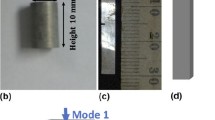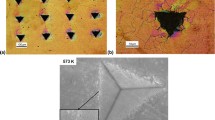Abstract
Commercially pure magnesium was processed by severe plastic deformation techniques and thermo-mechanical routes to produce samples with grain sizes in the range from 1.0 to 300 µm. Tensile testing of a fine-grained material revealed a decrease in hardening and an increase in strain rate sensitivity with decreasing testing strain rate from 10−2 to 10−7 s−1. Compression testing of fine-grained samples not only revealed similar trend, but also there was a transition from twinning to slip-dominated flow. Dynamic ultra-microhardness testing showed an increase in strain rate sensitivity with decreasing grain size. The trend of decreasing hardening rate and increasing strain rate sensitivity with decreasing strain rate was not observed in samples with a coarser grain size. Compression testing at different temperatures suggests that a creep mechanism with stress exponent of ~7 and activation energy close to grain boundary diffusion operates at low strain rates and moderate temperatures. A model for a new deformation mechanism is proposed based on the present experimental results and published data.












Similar content being viewed by others
References
Yoshinaga H, Horiuchi R (1963) Deformation mechanisms in magnesium single crystals compressed in the direction parallel to hexagonal axis. Trans JIM 4:1–8
Yoshinaga H, Horiuchi R (1963) On the non basal slip in magnesium crystals. Trans JIM 5:14–21
Partridge PG (1967) The crystallography and deformation modes of hexagonal close-packed metals. Metall Rev 12:169–194
Obara T, Yoshinga H, Morozumi S (1973) \( \{ 11\bar{2}2\} \langle \bar{1}\bar{1}23\rangle \) slip system in magnesium. Acta Metall 21:845–853
Barnett MR, Keshavarz Z, Beer AG, Atwell D (2004) Influence of grain size on the compressive deformation of wrought Mg-3Al-1Zn. Acta Mater 52:5093–5103
Jain A, Duygulu O, Brown DW, Tomé CN, Agnew SR (2008) Grain size effects on the tensile properties and deformation mechanisms of a magnesium alloy, AZ31B. Mater Sci Eng A 486:545–555
Koike J, Kobayashi T, Mukai T, Watanabe H, Suzuki M, Maruyama K, Higashi K (2003) The activity of non-basal slip systems and dynamic recovery at room temperature in fine-grained AZ31B magnesium alloys. Acta Mater 51:2055–2065
Beyerlein IJ, Capolungo L, Marshall PE, McCabe RJ, Tomé CN (2010) Statistical analyses of deformation twinning in magnesium. Philos Mag 90:2161–2190
Máthis K, Nyilas K, Axt A, Dragomir-Cernatescu I, Ungár T, Lukác P (2004) The evolution of non-basal dislocations as a function of deformation temperature in pure magnesium determined by X-ray diffraction. Acta Mater 52:2889–2894
Molodov KD, Al-Samman T, Molodov DA, Gottstein G (2014) Mechanisms of exceptional ductility of magnesium single crystal during deformation at room temperature: Multiple twinning and dynamic recrystallization. Acta Mater 76:314–330
Dixit N, Xie KY, Hemker KJ, Ramesh KT (2015) Microstructural evolution of pure magnesium under high strain rate loading. Acta Mater 87:56–67
Nave MD, Barnett MR (2004) Microstructures and textures of pure magnesium deformed in plane-strain compression. Scr Mater 51:881–885
Cepeda-Jiménez CM, Molina-Aldareguia JM, Pérez-Prado MT (2015) Origin of the twinning to slip transition with grain size refinement, with decreasing strain rate and with increasing temperature in magnesium. Acta Mater 88:232–244
Cepeda-Jiménez CM, Molina-Aldareguia JM, Pérez-Prado MT (2015) Effect of grain size on slip activity in pure magnesium polycrystals. Acta Mater 84:443–456
Valiev RZ, Langdon TG (2006) Principles of equal-channel angular pressing as a processing tool for grain refinement. Prog Mater Sci 51:881–981
Zhilyaev AP, Langdon TG (2008) Using high-pressure torsion for metal processing: fundamentals and applications. Prog Mater Sci 53:893–979
Iwahashi Y, Wang J, Horita Z, Nemoto M, Langdon TG (1996) Principle of equal-channel angular pressing for the processing of ultra-fine grained materials. Scr Mater 35:143–146
Furukawa M, Iwahashi Y, Horita Z, Nemoto M, Langdon TG (1998) The shearing characteristics associated with equal-channel angular pressing. Mater Sci Eng A 257:328–332
Shahmir H, Nili-Ahmadabadi M, Mansouri-Arani M, Khajezade A, Langdon TG (2014) Evaluating a new core-sheath procedure for processing hard metals by equal-channel angular pressing. Adv Eng Mater 16:918–926
Li Y, Ng HP, Jung HD, Kim HE, Estrin Y (2014) Enhancement of mechanical properties of grade 4 titanium by equal channel angular pressing with billet encapsulation. Mater Lett 114:144–147
Cetlin PR, Aguilar MTP, Figueiredo RB, Langdon TG (2010) Avoiding cracks and inhomogeneities in billets processed by ECAP. J Mater Sci 45:4561–4570. doi:10.1007/s10853-010-4384-9
Figueiredo RB, Cetlin PR, Langdon TG (2011) Using finite element modeling to examine the flow processes in quasi-constrained high-pressure torsion. Mater Sci Eng A 528:8198–8204
Figueiredo RB, Pereira PHR, Aguilar MTP, Cetlin PR, Langdon TG (2012) Using finite element modeling to examine the temperature distribution in quasi-constrained high-pressure torsion. Acta Mater 60:3190–3198
Pereira PHR, Figueiredo RB, Huang Y, Cetlin PR, Langdon TG (2014) Modeling the temperature rise in high-pressure torsion. Mater Sci Eng A 593:185–188
Figueiredo RB, Száraz Z, Trojanová Z, Lukác P, Langdon TG (2010) Significance of twinning in the anisotropic behavior of a magnesium alloy processed by equal-channel angular pressing. Scr Mater 63:504–507
Chun YB, Davies CHJ (2011) Twinning-induced negative strain rate sensitivity in wrought Mg alloy AZ31. Mater Sci Eng A 528:5713–5722
Li J, Xu W, Wu X, Ding H, Xia K (2011) Effects of grain size on compressive behaviour in ultrafine grained pure Mg processed by equal channel angular pressing at room temperature. Mater Sci Eng A 528:5993–5998
Choi HJ, Kim Y, Shin JH, Bae DH (2010) Deformation behavior of magnesium in the grain size spectrum from nano- to micrometer. Mater Sci Eng A 527:1565–1570
Hwang S, Nishimura C, McCormick PG (2001) Deformation mechanism of nanocrystalline magnesium in compression. Scr Mater 44:1507–1511
Somekawa H, Mukai T (2015) Hall-Petch breakdown in fine-grained pure magnesium at low strain rates. Metall Mater Trans 46A:894–902
Mayo MJ, Nix WD (1988) A micro-indentation study of superplasticity in Pb, Sn, and Sn-38 wt% Pb. Acta Metall 36:2183–2192
Somekawa H, Mukai T (2010) Nanoindentation creep behavior of grain boundary in pure magnesium. Philos Mag Lett 90:883–890
Somekawa H, Mukai T (2012) Effect of grain boundary structures on grain boundary sliding in magnesium. Mater Lett 76:32–35
Choi I-C, Lee D-H, Ahn B, Durst K, Kawasaki M, Langdon TG, Jang J (2015) Enhancement of strain-rate sensitivity and shear yield strength of a magnesium alloy processed by high-pressure torsion. Scr Mater 94:44–47
Frost HJ, Ashby MF (1982) Deformation-mechanism maps: the plasticity and creep of metals and ceramics. Pergamon Press, Oxford
Acknowledgements
This work was supported in part by CNPq, FAPEMIG, and CAPES and in part by the European Research Council under ERC Grant Agreement No. 267464-SPDMETALS.
Author information
Authors and Affiliations
Corresponding author
Ethics declarations
Conflict of interest
The authors declare that they have no conflict of interest.
Rights and permissions
About this article
Cite this article
Figueiredo, R.B., Poggiali, F.S.J., Silva, C.L.P. et al. The influence of grain size and strain rate on the mechanical behavior of pure magnesium. J Mater Sci 51, 3013–3024 (2016). https://doi.org/10.1007/s10853-015-9612-x
Received:
Accepted:
Published:
Issue Date:
DOI: https://doi.org/10.1007/s10853-015-9612-x




